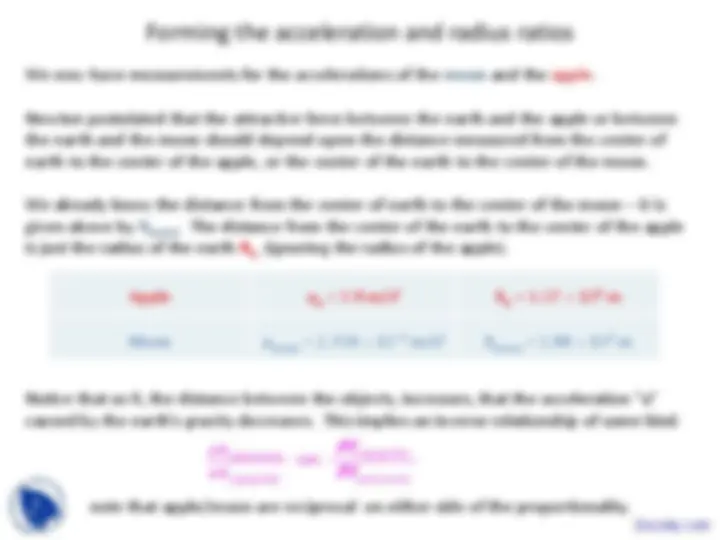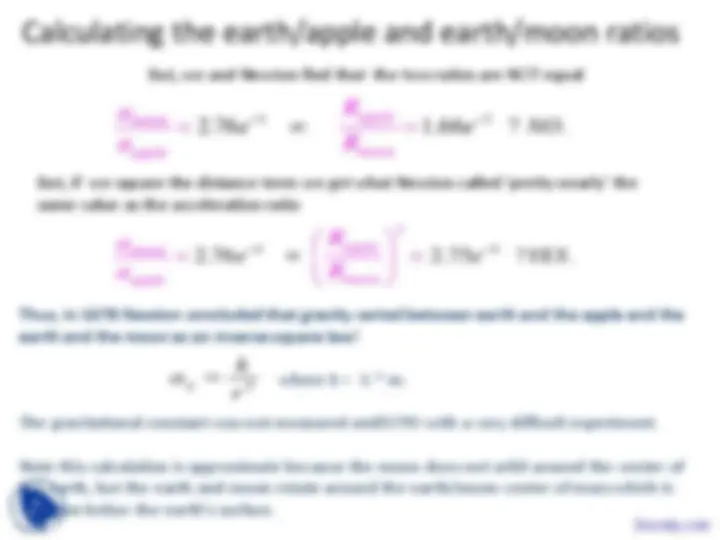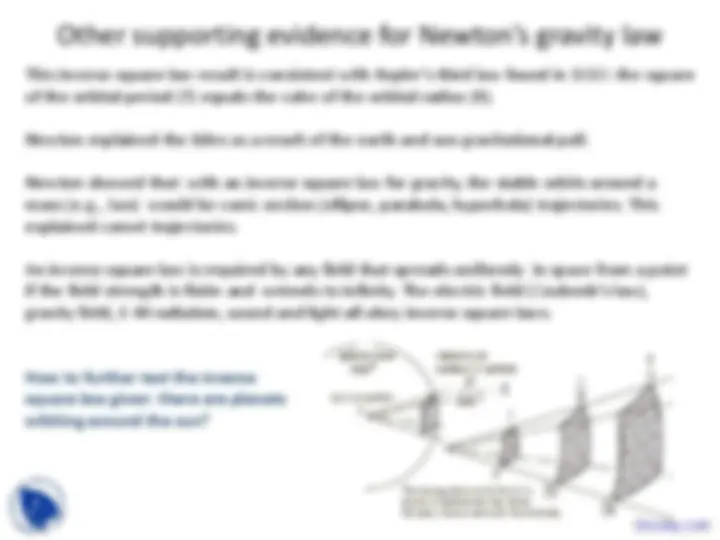





Study with the several resources on Docsity

Earn points by helping other students or get them with a premium plan


Prepare for your exams
Study with the several resources on Docsity

Earn points to download
Earn points by helping other students or get them with a premium plan
Community
Ask the community for help and clear up your study doubts
Discover the best universities in your country according to Docsity users
Free resources
Download our free guides on studying techniques, anxiety management strategies, and thesis advice from Docsity tutors
An insightful look into newton's groundbreaking discovery of the inverse square law of gravity. By comparing the accelerations of an apple falling towards the earth and the moon's motion around the earth, newton determined that the force of gravity varies inversely with the square of the distance from the center of the mass causing the gravitational pull. This document also includes historical context, providing a deeper understanding of the scientific revolution and the challenges faced by pioneering scientists like galileo and newton.
Typology: Slides
1 / 7

This page cannot be seen from the preview
Don't miss anything!




From observations of the night sky, it was clear to Newton (and many before him) that there must be some form of attraction between the earth and the moon, and the sun and the planets that caused them to orbit around the Sun.
Yet, it was not at all clear that the same force of attraction could be responsible for the behavior of falling bodies near the surface of the earth.
Newton postulated that one force called gravity was responsible for both motions. His problem, then, was to attempt to determine the force law.
His method involved a comparison of the motions of the moon around the earth and an object (e.g., apple) falling towards the earth. Since neither the apple or the moon are moving in a straight line at constant speed, they must each be undergoing an acceleration.
Would it be possible to determine the nature of the force responsible for that acceleration? In order to do so, he must first determine the accelerations of the moon and the apple.
Know Facts about earth and moon
Fact -1: Measured. The acceleration of the apple is 9.8 m/s^2 or aA = 9.8 m/s^2.
Fact-2: The radius of the earth is RA = 6.37 × 106 m.
Fact-3: Measured. The distance from the earth to the moon is Rmoon = 3.84 × 108 m.
Fact-4: Measured. The moon goes around the earth once in 27.3 days.
Calc-1: Cmoon = 2 π Rmoon = 2 × π × (3.84 × 108 ) = 2.413 × 109 m.
Calc-2: vmoon = Cmoon ÷ (27.3 × 24 × 60 × 60) = 1019 m/s.
Since the moon is in (nearly) circular orbit around the earth, its motion can be approximated as circular. Therefore, the acceleration of the moon is a centripetal acceleration whose formula was discovered by Christian Huygen’s in 1657.
And that value is
Calc-3: amoon = v^2 moon / Rmoon = 1019^2 / 3.84 × 108 = 2.704 × 10 −^3 m/s 2
Calculating the earth/apple and earth/moon ratios
But, we and Newton find that the two ratios are NOT equal
apple moon
But, if we square the distance term we get what Newton called ‘pretty nearly’ the same value as the acceleration ratio 2
apple moon
Thus, in 1678 Newton concluded that gravity varied between earth and the apple and the earth and the moon as an inverse square law!
where k = G * m.
The gravitational constant was not measured until1789 with a very difficult experiment.
Note this calculation is approximate because the moon does not orbit around the center of the earth, but the earth and moon rotate around the earth/moon center of mass which is 1000 km below the earth’s surface.
g 2
Other supporting evidence for Newton’s gravity law
This inverse square law result is consistent with Kepler’s third law found in 1610: the square of the orbital period (T) equals the cube of the orbital radius (R).
Newton explained the tides as a result of the earth and sun gravitational pull.
Newton showed that with an inverse square law for gravity, the stable orbits around a mass (e.g., Sun) would be conic section (ellipse, parabola, hyperbola) trajectories. This explained comet trajectories.
An inverse square law is required by any field that spreads uniformly in space from a point if the field strength is finite and extends to infinity. The electric field (Coulomb’s law), gravity field, E-M radiation, sound and light all obey inverse square laws.
How to further test the inverse square law given there are planets orbiting around the sun?
Aristotle and Church versus Galileo
Galileo at end of Inquisition in 1633 after being forced under pain of death to recant his theory that the earth moves around the sun:
“ and yet it moves”.